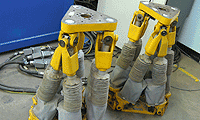


| home |
| about the meeting |
| main speakers/courses |
| talks/posters |
| registration form |
| organizers |
| travel & accomodations |
| participants |
| poster |
| timetable |
| contacts |
| documentation |
| imp |
5th Porto Meeting on MATHEMATICS for INDUSTRY
10th and 11th April 2014
Short Presentations
- 14h30 Rui Rei, "Tree Search for the Recursive Circle Packing Problem"
- 15h00 Margarida Carvalho, "Lot sizing games"
- 15h30 Filipe Brandão, "Bin Packing and Related Problems: General Arc-flow Formulation with Graph Compression"
- 16h00 Bruno Vieira, "Multi-criteria decisions on unit commitment"
16h30 Coffee break
- 17h00 Ana Carvalho, "Mathematical model for HIV dynamics in HIV-specific helper cells"
- 17h30 Isabel Cristina Lopes, "Scheduling aircrafts’ engine repair process: a mathematical model"
- 18h00 Eliana Costa e Silva "A Mathematical Model for Supermarket Order Picking"
Abstracts
- Rui Rei, "Tree Search for the Recursive Circle Packing Problem"
Abstract: The Recursive Circle Packing Problem has
direct practical application in the tube industry, where
tubes of various inner and outer diameters must be
packed in rectangular containers for shipping to
customers. Although the problem can be posed in various
ways, in this paper we focus on maximizing the total
value of the tubes packed in a single container,
allowing tubes to be placed inside other tubes
recursively.
We explore the application of several variants of Tree
Search to this problem, propose symmetry-breaking
optimizations, and study the threshold of complete
search using toy instances. Finally, we conduct a full
computational experiment on a small set of benchmark
instances, comparing adaptations of the proposed
algorithms for incomplete search to previous results.
- Filipe Brandão, "Bin Packing and Related Problems: General Arc-flow Formulation with Graph Compression"
Abstract: We present an exact method, based on an
arc-flow formulation with side constraints, for solving
bin packing and cutting stock problems --- including
multi-constraint variants --- by simply representing all
the patterns in a very compact graph. Our method
includes a graph compression algorithm that usually
reduces the size of the underlying graph substantially
without weakening the model. As opposed to our method,
which provides strong models, conventional models are
usually highly symmetric and provide very weak lower
bounds.
Our formulation is equivalent to Gilmore and Gomory's,
thus providing a very strong linear relaxation. However,
instead of using column-generation in an iterative
process, the method constructs a graph, where paths from
the source to the target node represent every valid
packing pattern. The same method, without any
problem-specific parameterization, was used to solve a
large variety of instances from several different
cutting and packing problems. We report computational
results obtained with many benchmark test data sets, all
of them showing a large advantage of this formulation
with respect to the traditional ones.
References:
Brandão, F. and Pedroso, J. P. (2013). Bin Packing and
Related Problems:
General Arc-flow Formulation with Graph Compression.
Technical Report
DCC-2013-08, Faculdade de Ciências da Universidade do
Porto, Universidade do
Porto, Portugal. Available at:
http://arxiv.org/abs/1310.6887
Brandão, F. and Pedroso, J. P. (2013). Multiple-choice
Vector Bin Packing:
Arc-flow Formulation with Graph Compression. Technical
Report DCC-2013-13,
Faculdade de Ciências da Universidade do Porto,
Universidade do Porto, Portugal.
Brandão, F. and Pedroso, J. P. (2013). Cutting Stock
with Binary Patterns:
Arc-flow Formulation with Graph Compression. Technical
Report DCC-2013-09,
Faculdade de Ciências da Universidade do Porto,
Universidade do Porto, Portugal.
Brandão, F. (2012). Bin Packing and Related Problems:
Pattern-Based Approaches.
Master’s thesis, Faculdade de Ciências da Universidade
do Porto, Portugal.
- Isabel Cristina Lopes, "Scheduling aircrafts’ engine repair process: a mathematical model"
Authors:
Isabel Cristina Lopes,
UNIAG/ESEIG-IPP/UM
Eliana Costa e Silva,
CIICESI/ESTGF-IPP/UM/UPT
Jorge Orestes Cerdeira,
FCT-UNL/ISA-UTL
Abstract:
We address a real world scheduling problem concerning
the repair process of aircrafts' engines by TAP -
Maintenance & Engineering (TAP-ME), which is
the maintenance, repair and overhaul organization of TAP
Portugal, Portugal's leading airline.
A mixed integer linear programming formulation based on
the flexible job shop scheduling is presented, allowing
operations to be executed on the same workstation by any
processor of a given set, with the objective of
minimizing the total weighted tardiness.
Computational experiment on a real instance provided by
TAP-ME from a regular working week was successful in
finding an optimal solution. We also tested the model
using benchmarking instances available in literature.
- Eliana Costa e Silva "A Mathematical Model for Supermarket Order Picking"
Eliana Costa e Silva
CIICECI/ESTGF-IPP/UM, e-mail: eos@estgf.ipp.pt
Manuel Cruz
LEMA/ISEP-IPP, email: mbc@isep.ipp.pt
Isabel Cristina Lopes
UNIAG/ESEIG-IPP/UM, email: cristinalopes@eu.ipp.pt
Ana Moura
LEMA/ISEP-IPP and CMUP, email: aim@isep.ipp.pt
Order picking consists in the retrieving of a number of
items from the storage locations to satisfy a number of
independent customers' orders. It is generally
recognized as one of the most significant activities in
a warehouse (Koster et al, 2007). According to different
authors, the order picking accounts up to 50% (Frazelle,
2001) or even 80% (Van den Berg, 1999) of the total
warehouse operating costs. The critical issue in today's
business environment is to simultaneously reduce the
cost and increase the speed of order picking. We address
the problem of order picking in one of the Portuguese
largest companies in the grocery business. Each operator
steers the trolley on the shop floor to select items to
multiple costumers. For each order, a picker may have to
walk a considerable distance. This problem was proposed
at the 92nd European Study Group with Industry (ESGI92).
The objective is to improve their grocery e-commerce and
bring it up to the level of the best internatio
nal practices. In particular, the company wants to
improve the routing tasks in order to decrease
distances. For this purpose, a mathematical model for a
faster open shop picking was developed. In this talk we
describe the problem as well as some preliminary results
and conclusions.